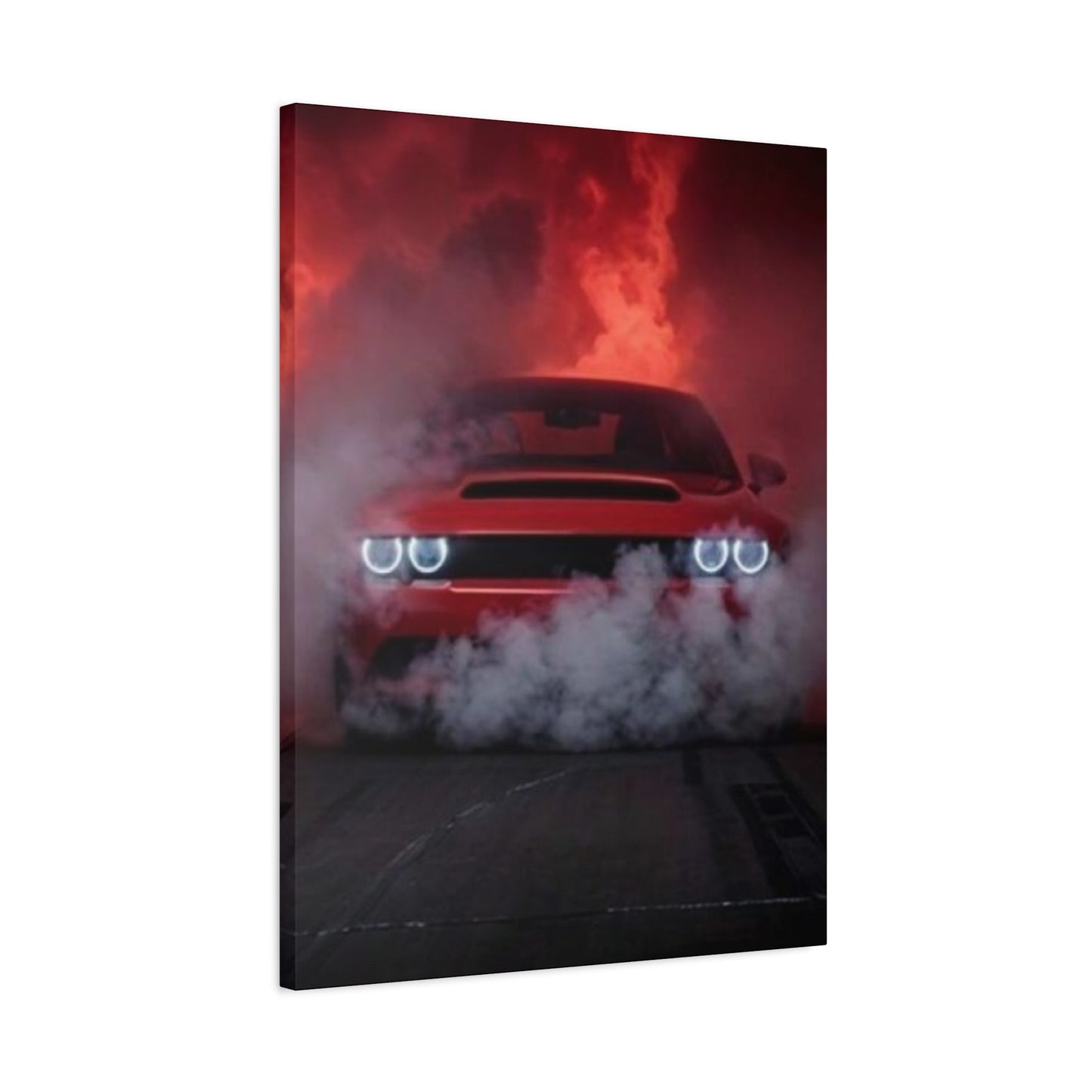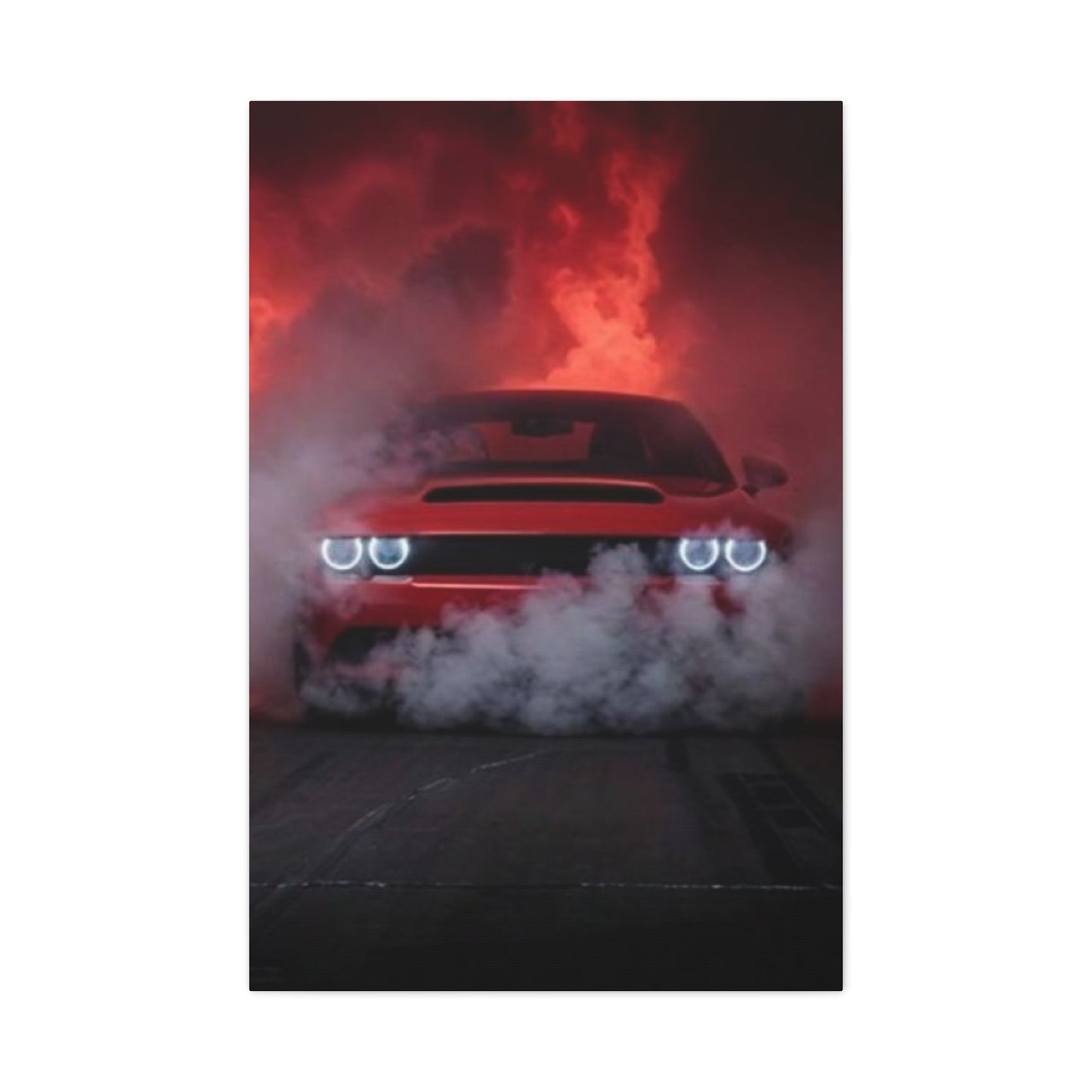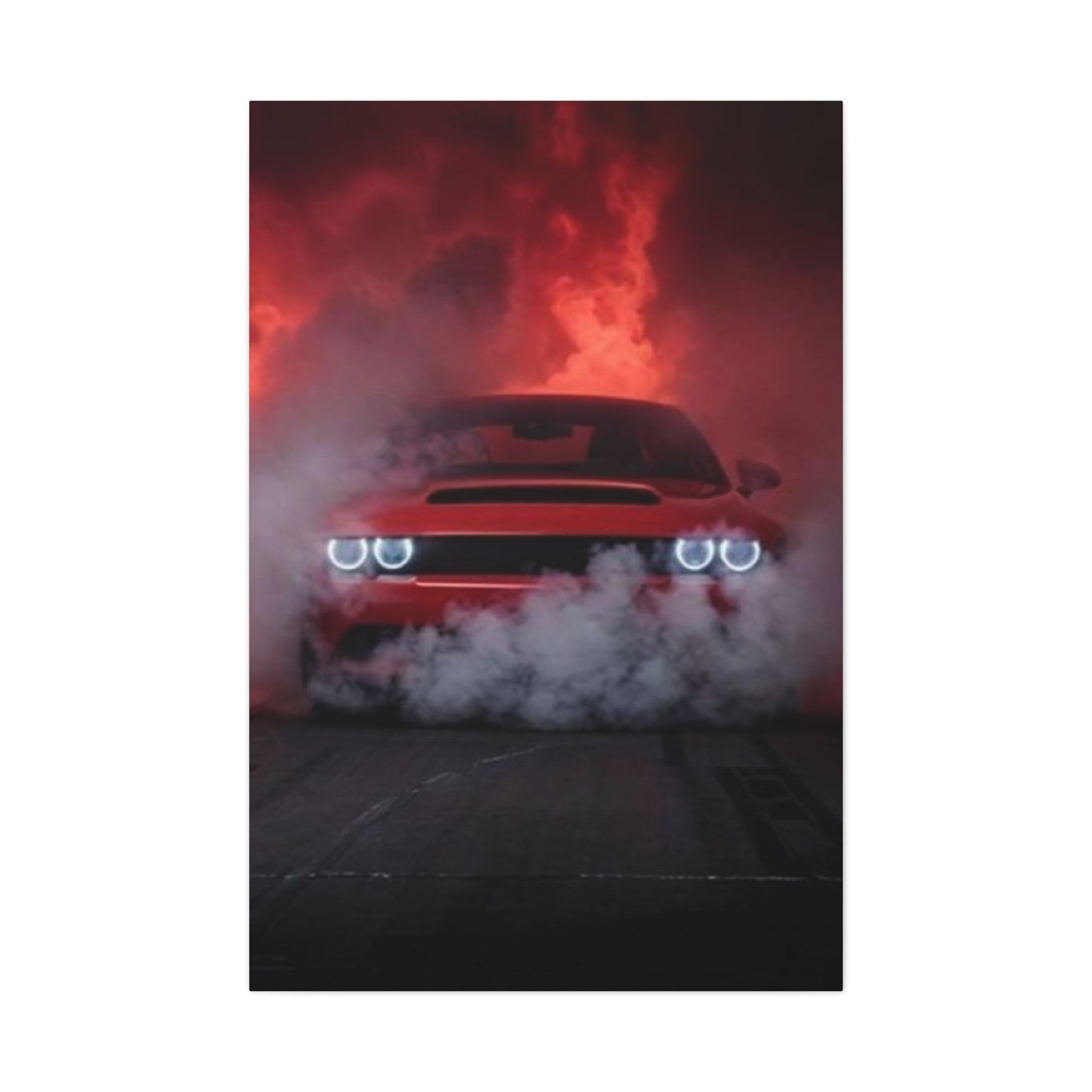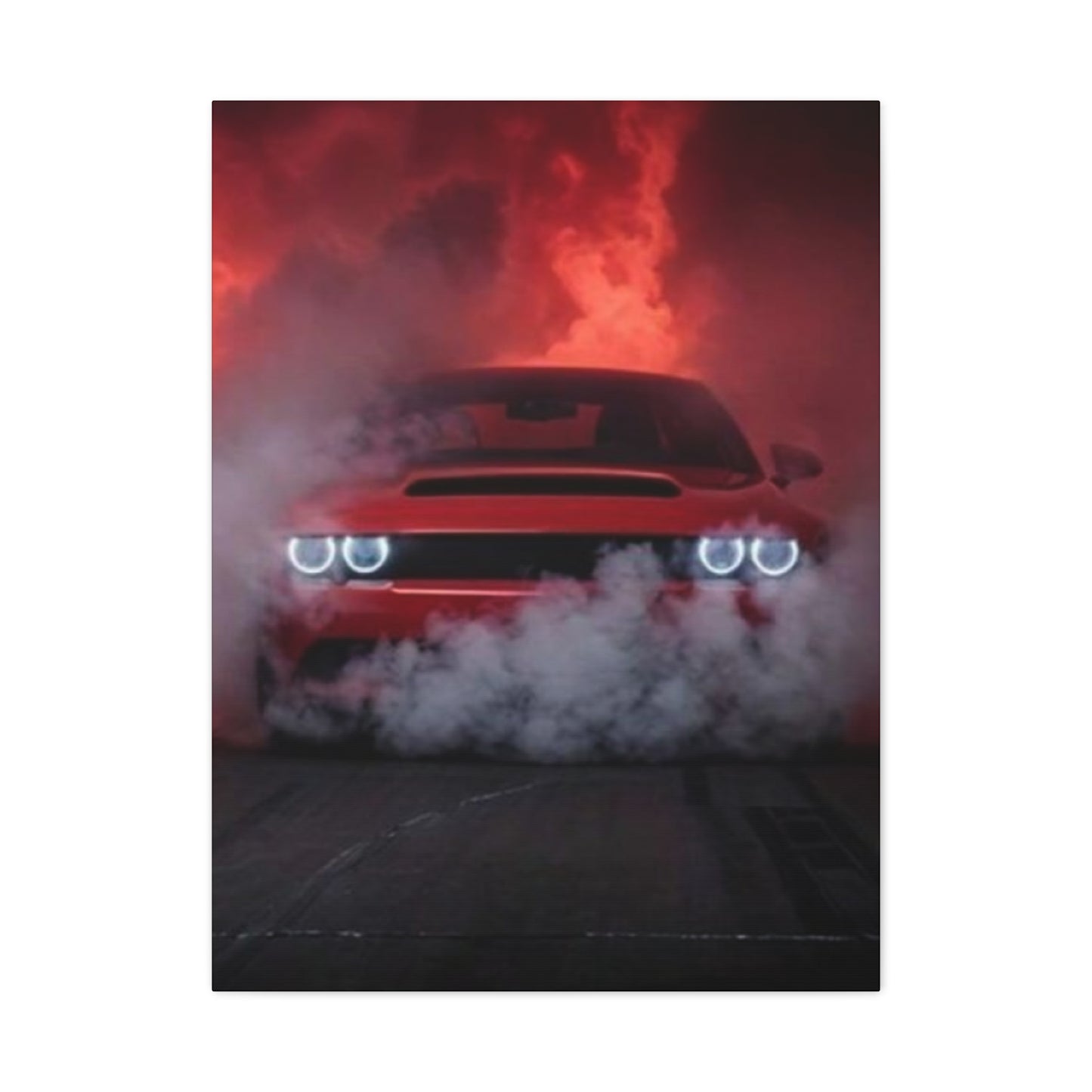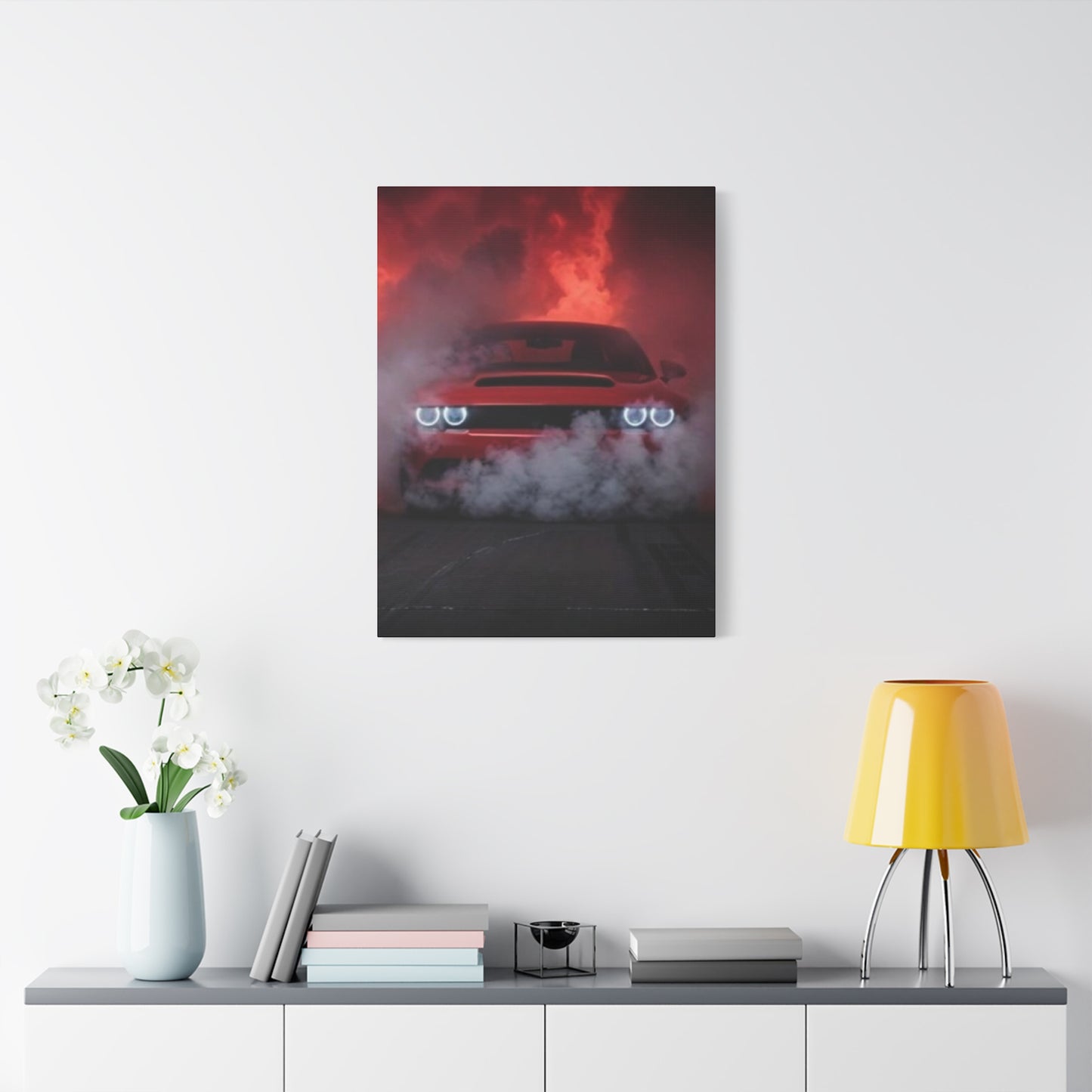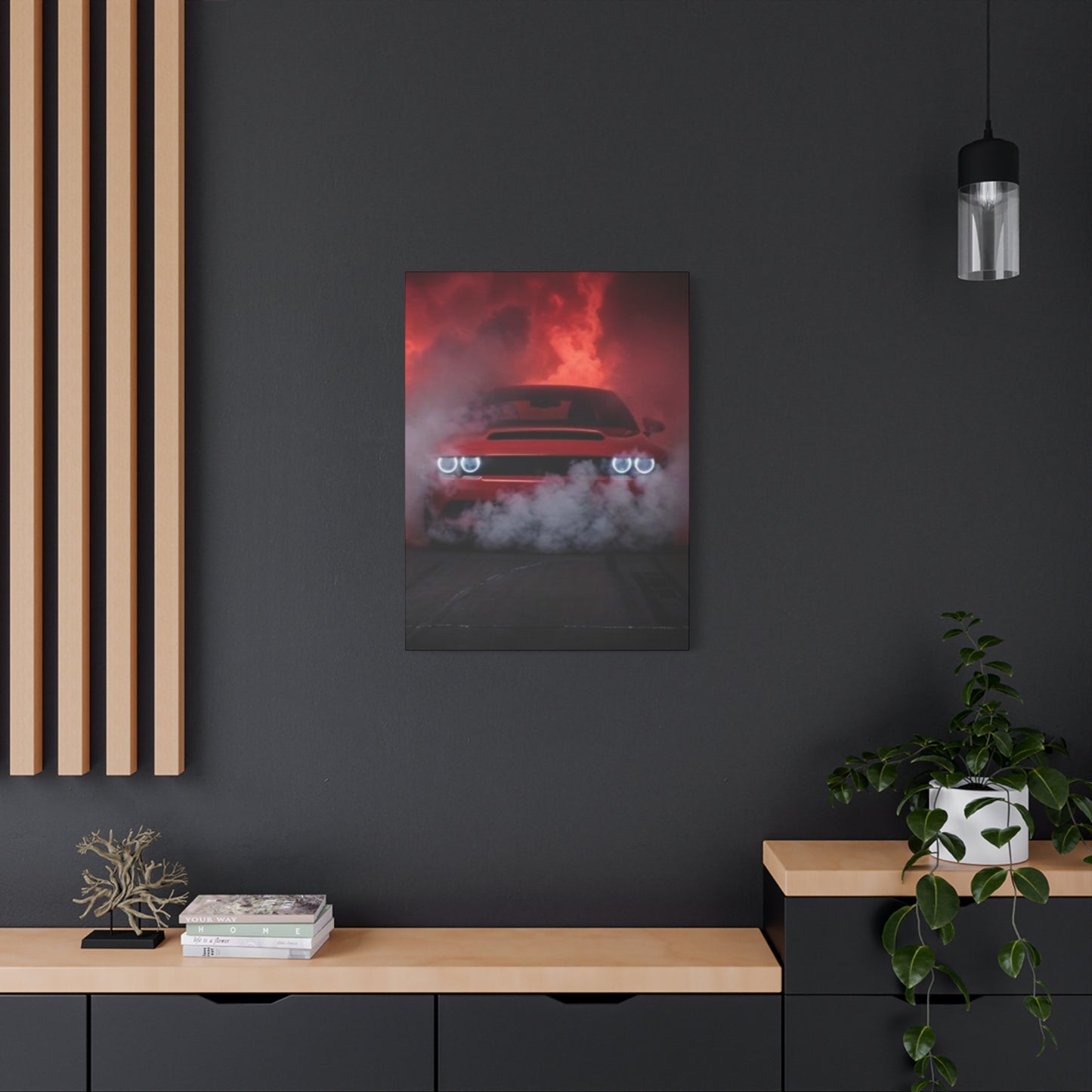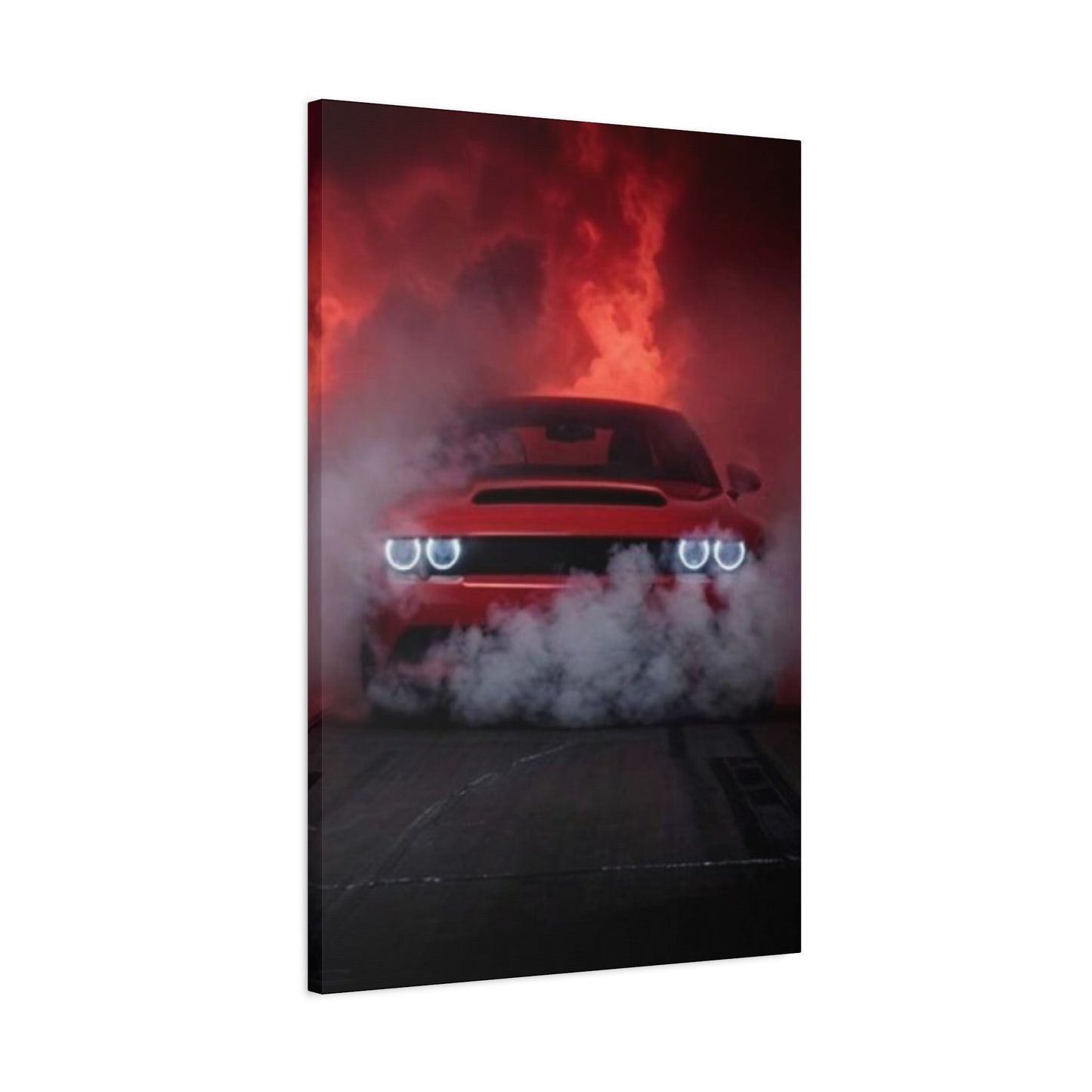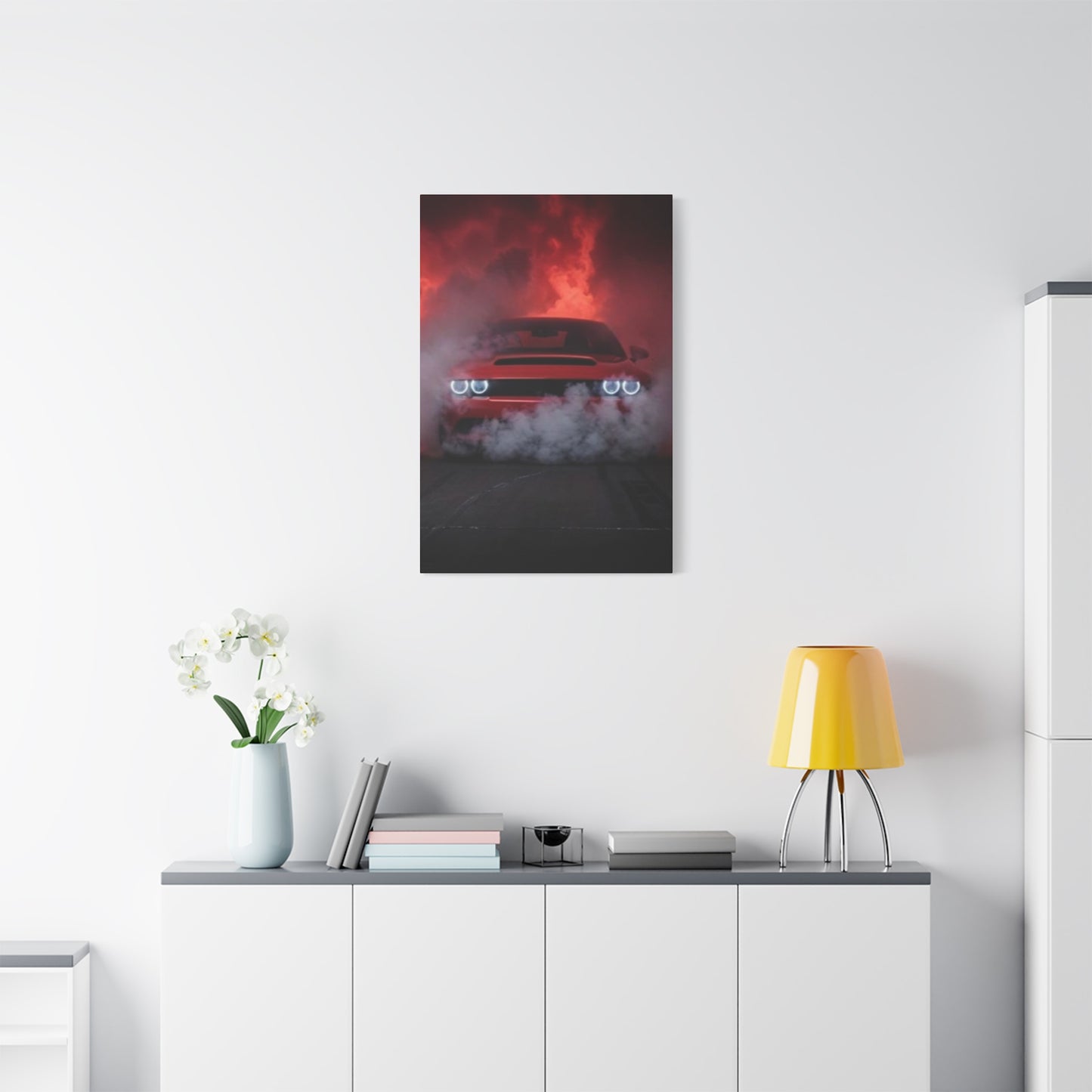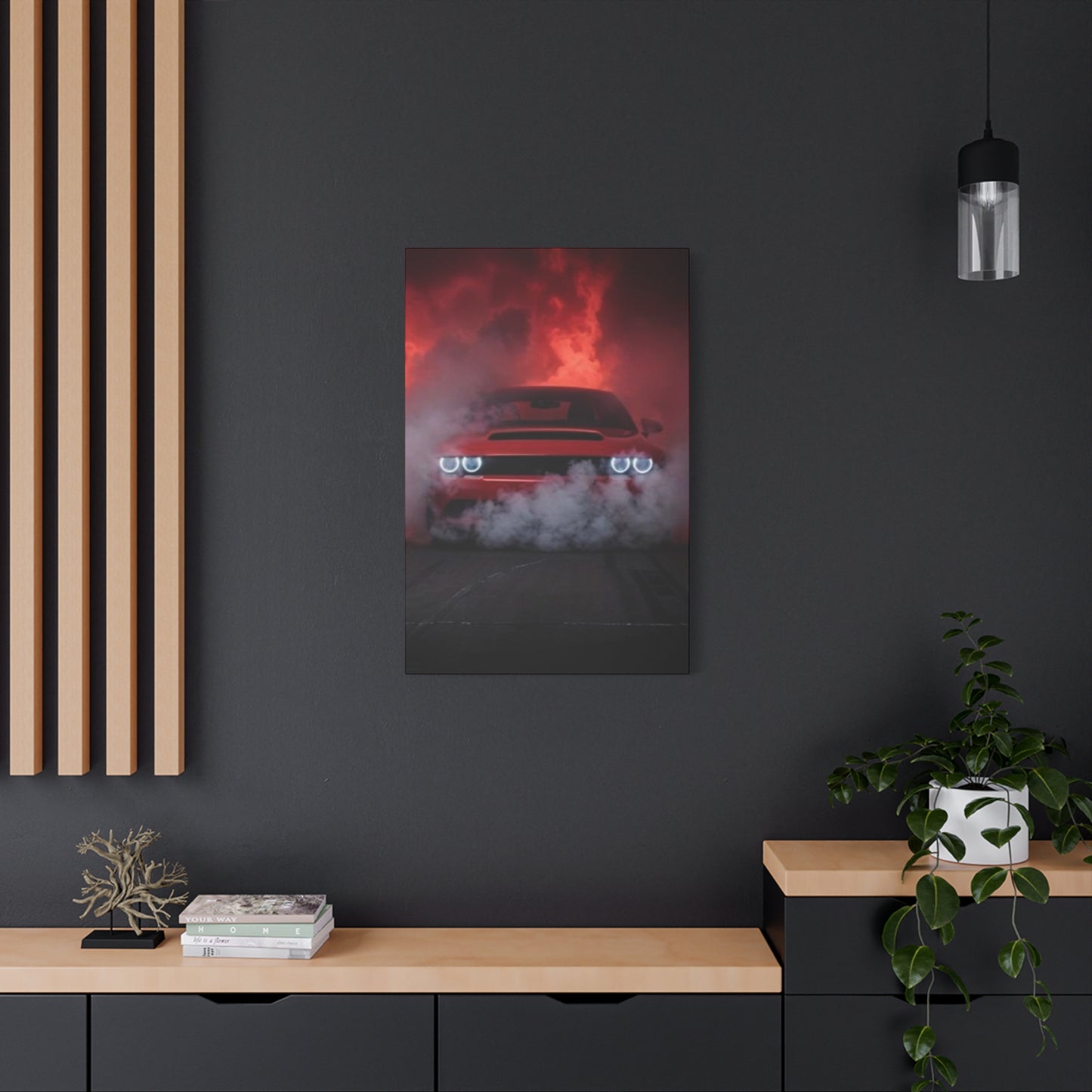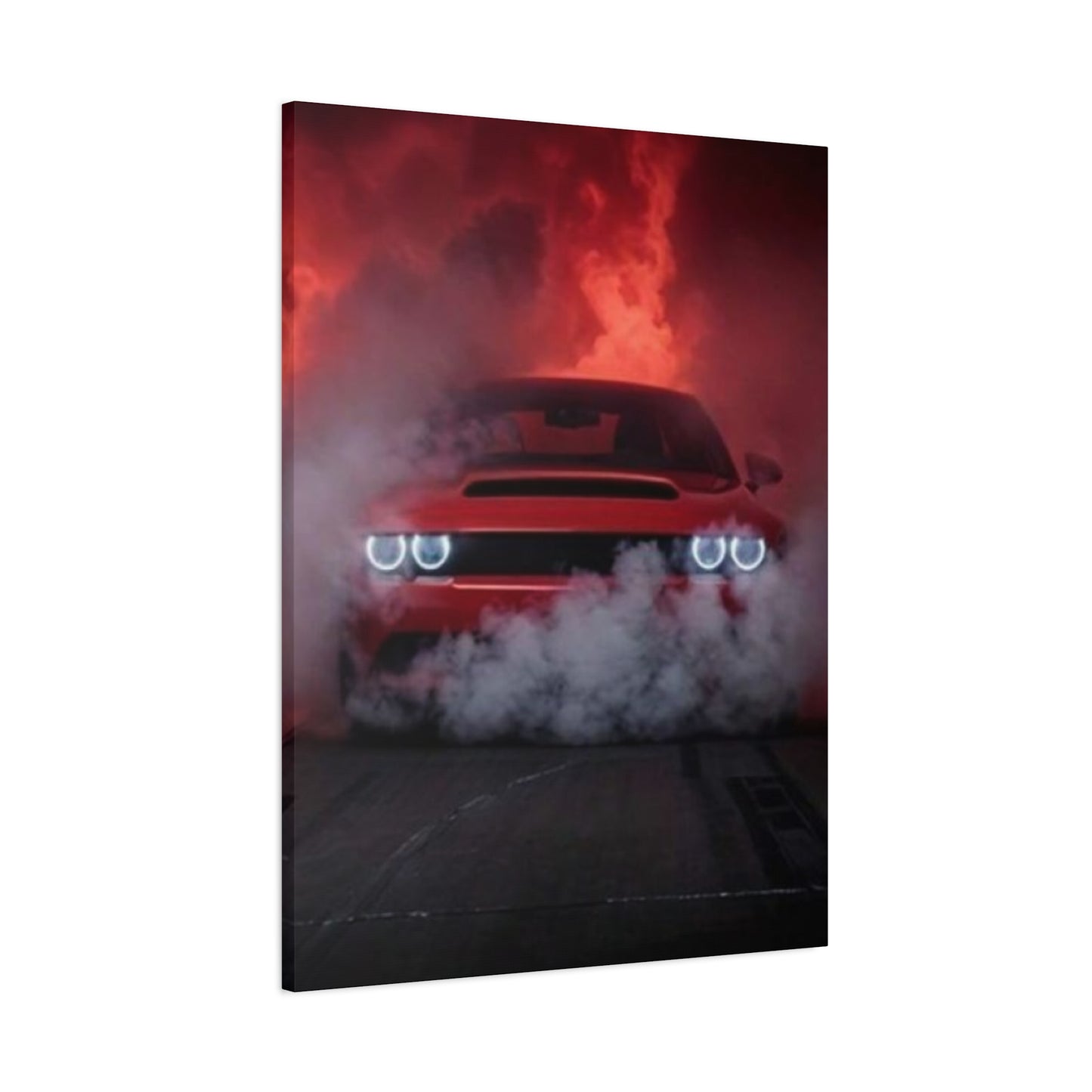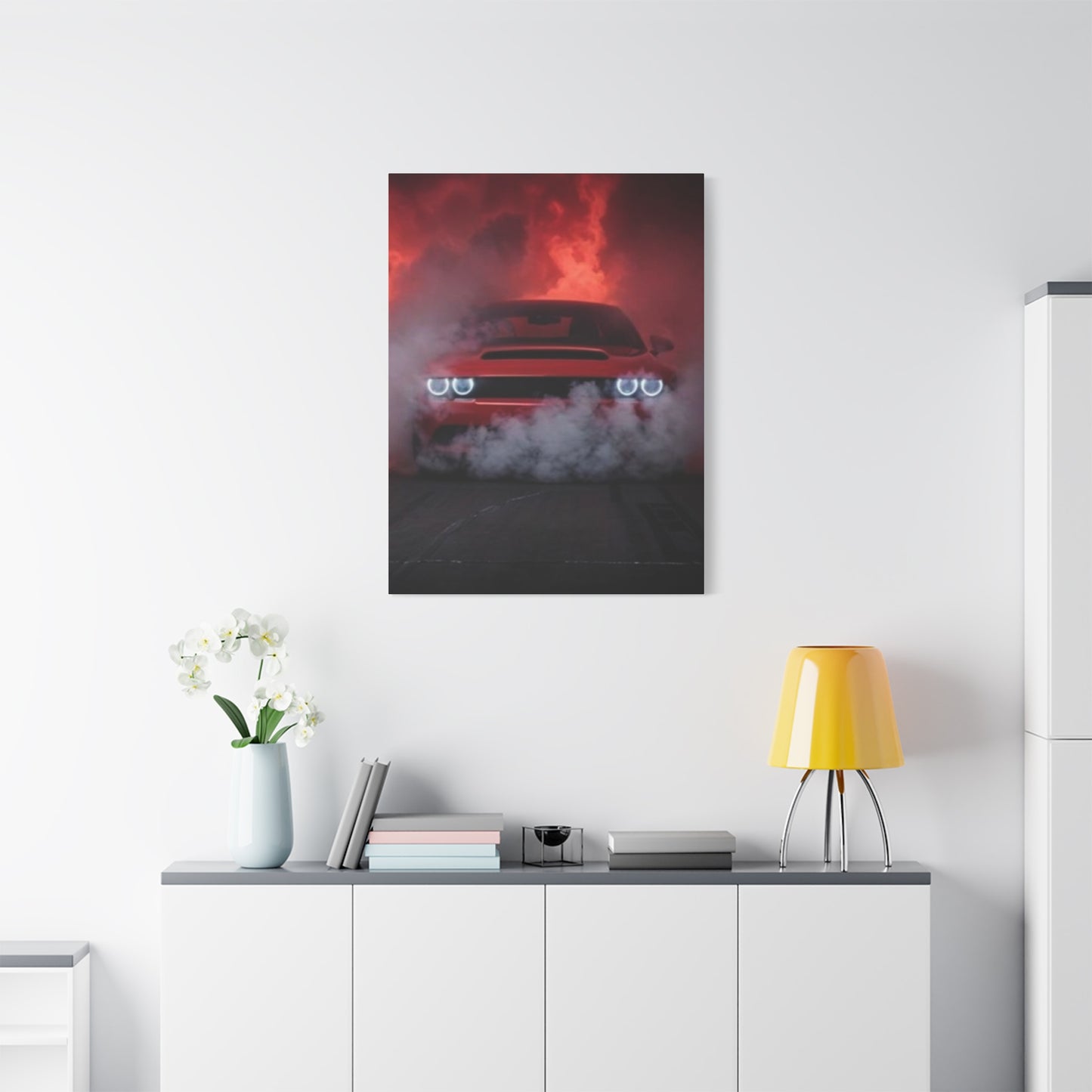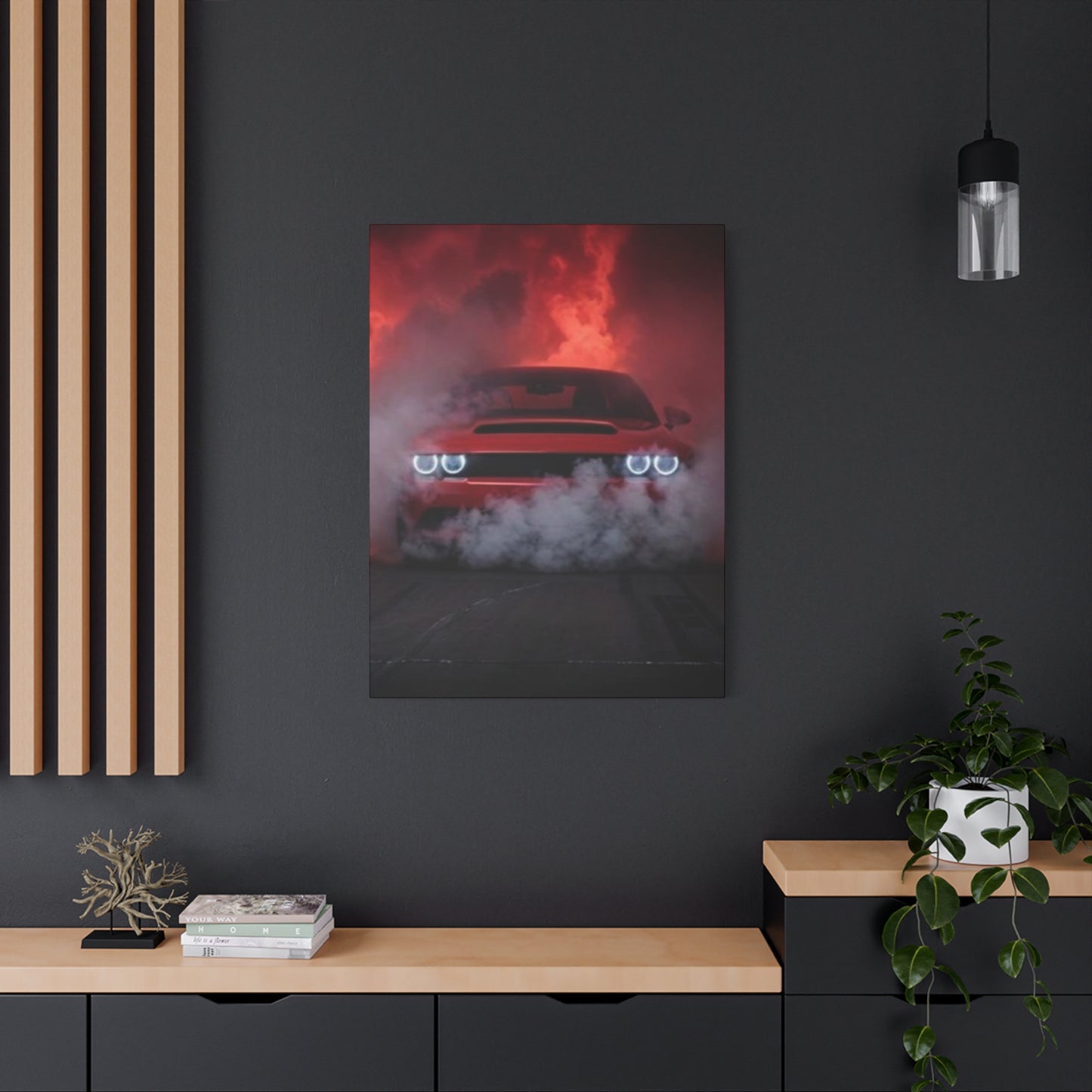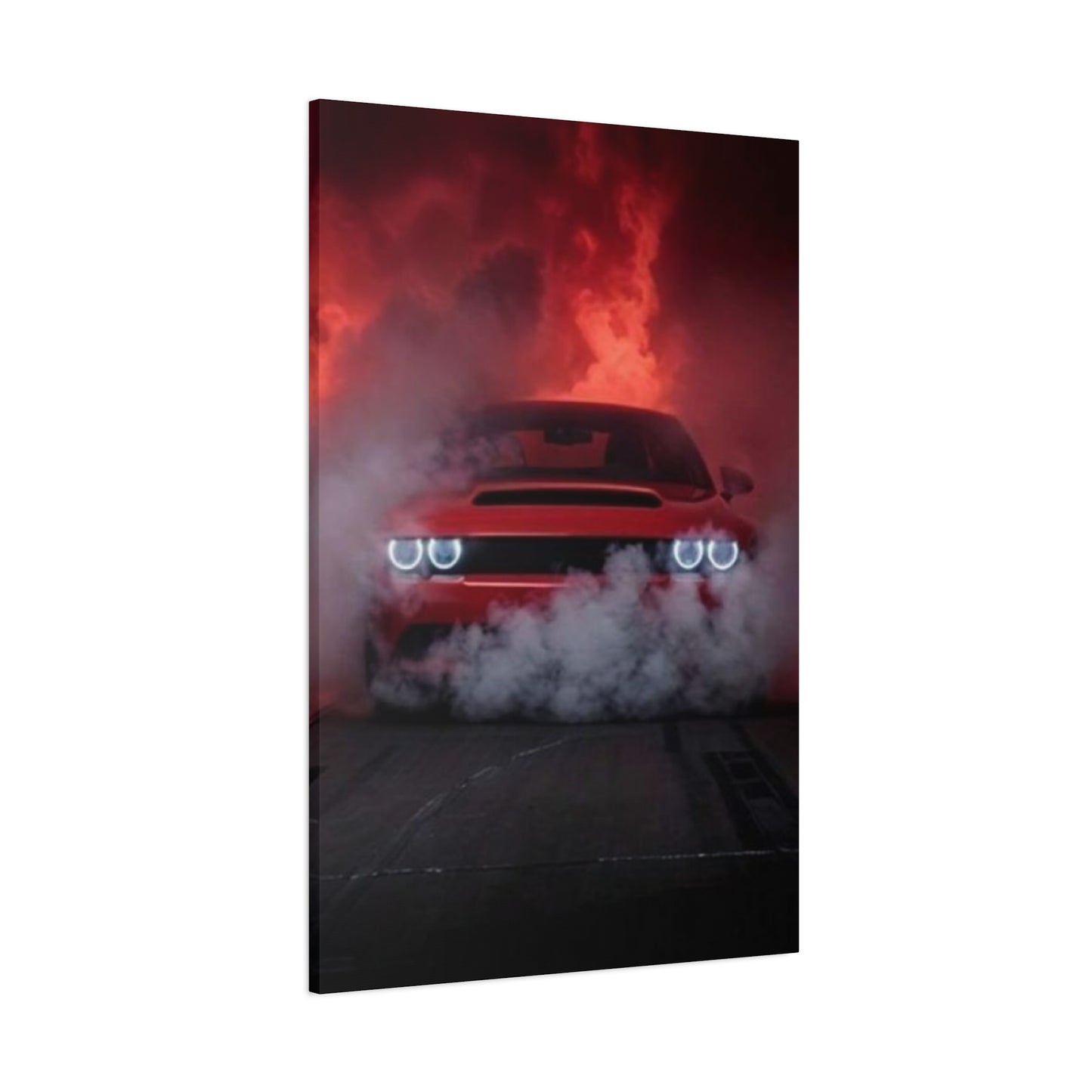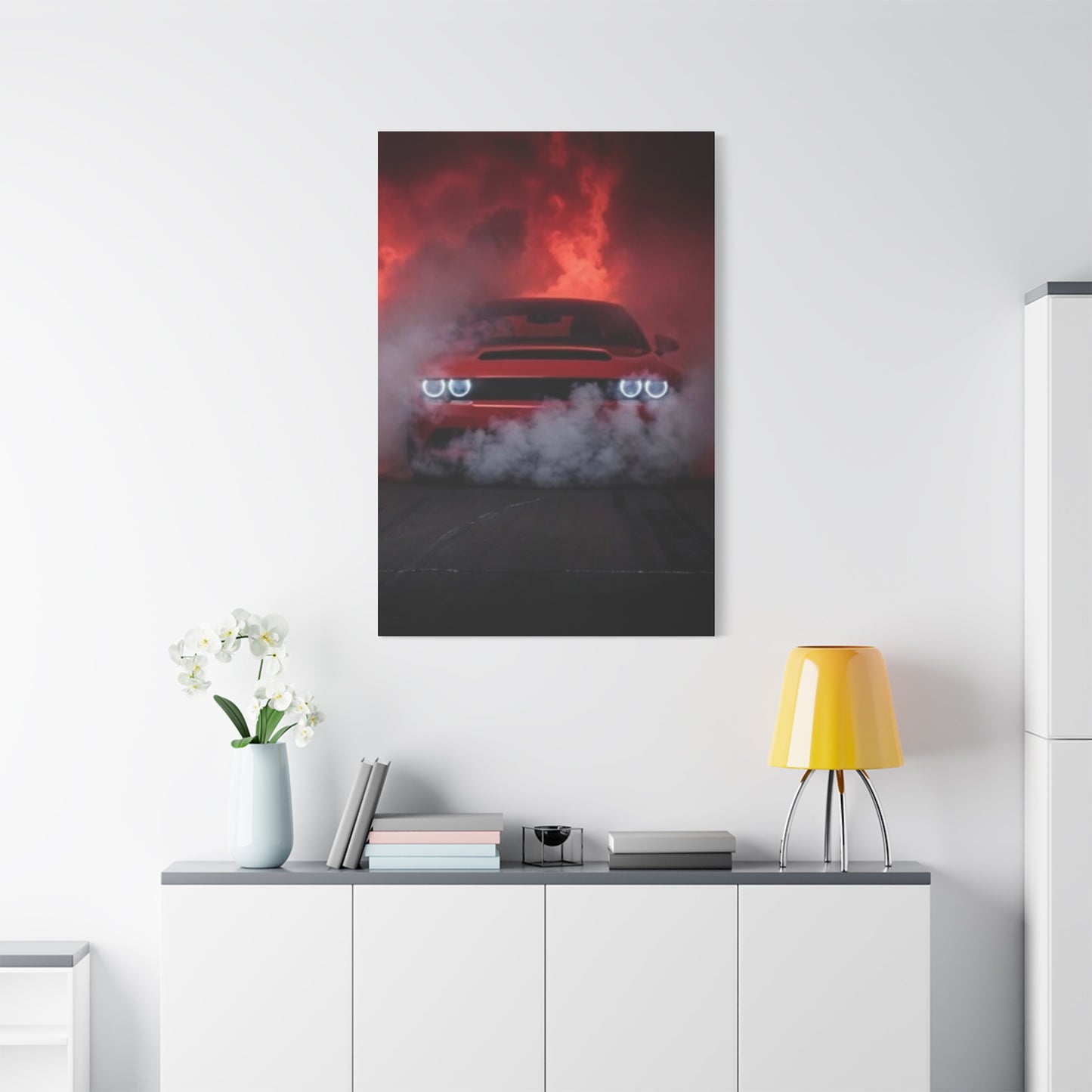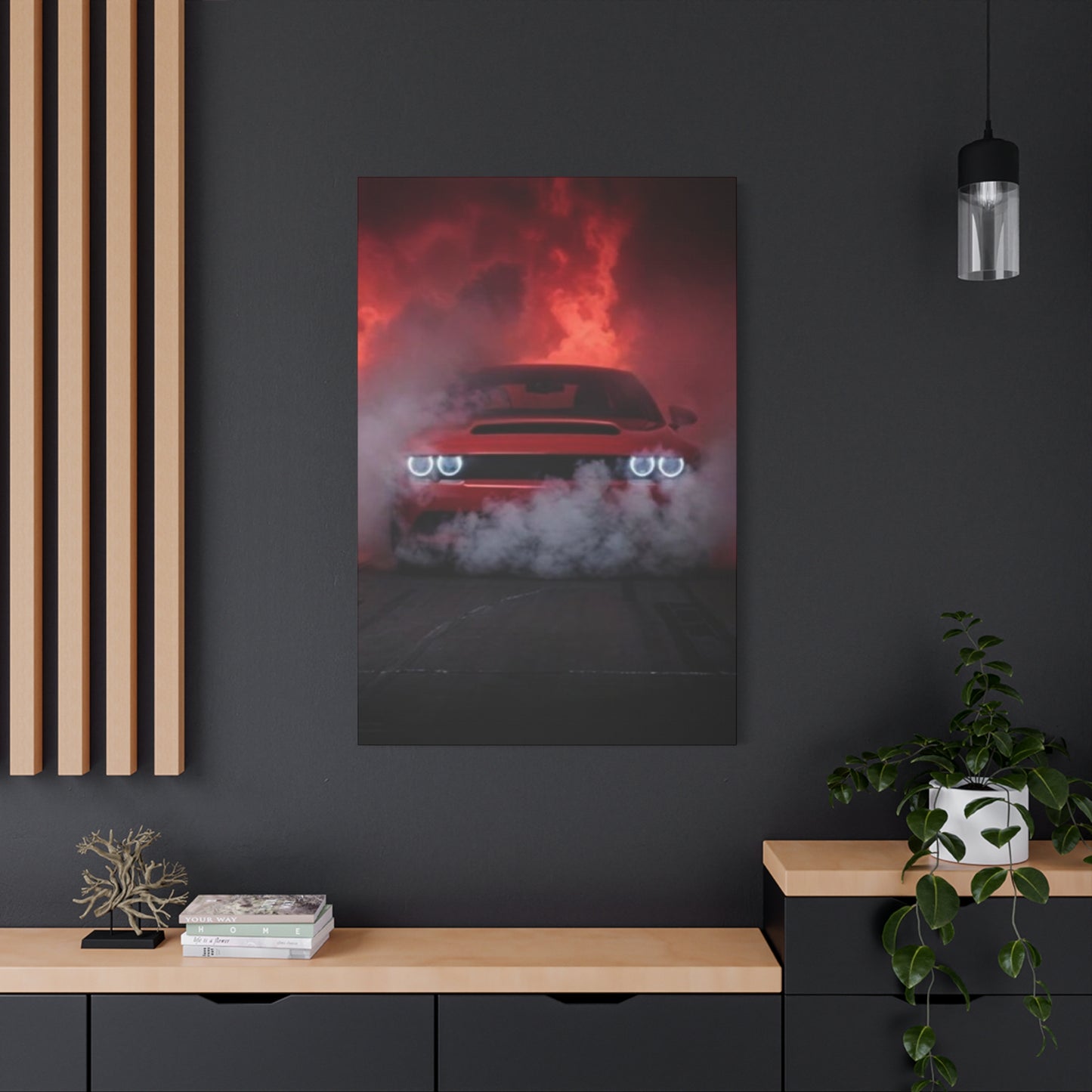Hellcat Burnout Man Cave Decor Wall Art: Revolutionary Automotive Artwork
The world of automotive artwork has evolved dramatically, bringing the raw power and aggressive beauty of muscle cars directly into personal sanctuaries. Hellcat burnout man cave decor wall art canvas prints represent the pinnacle of this evolution, capturing the essence of American muscle car culture in stunning visual formats. These exceptional pieces transform ordinary rooms into dynamic showcases that celebrate the thunderous roar and tire-smoking spectacle of Dodge's most powerful production vehicles.
The appeal of Hellcat burnout imagery extends far beyond simple automotive appreciation. These canvas prints embody the spirit of rebellion, performance, and mechanical excellence that defines modern American muscle cars. Each piece serves as a testament to engineering prowess while delivering visceral excitement through carefully crafted visual compositions. The combination of smoke, rubber, and raw horsepower creates compelling artwork that resonates with enthusiasts on multiple levels.
Modern canvas printing technology has revolutionized how automotive artwork is produced and displayed. High-resolution digital printing processes ensure that every detail of tire smoke, engine bay components, and aggressive styling elements is captured with remarkable clarity. The canvas medium itself adds texture and depth to the images, creating a more engaging viewing experience than traditional paper prints or digital displays.
The popularity of man cave decor has created unprecedented demand for specialized automotive artwork. Hellcat burnout canvas prints perfectly satisfy this demand by offering bold, masculine imagery that complements modern recreational environments. These pieces serve as conversation starters, mood setters, and focal points that define the character of personal entertainment areas.
Quality considerations play a crucial role in selecting Hellcat burnout canvas prints. Premium materials, fade-resistant inks, and proper mounting techniques ensure longevity and visual impact over time. The investment in high-quality canvas prints pays dividends through years of enjoyment and maintained aesthetic appeal.
Hellcat Performance Legacy and Visual Impact
The Dodge Challenger SRT Hellcat and Charger SRT Hellcat represent the current pinnacle of American muscle car development. These vehicles produce over 700 horsepower from their supercharged 6.2-liter HEMI V8 engines, creating performance capabilities that translate into spectacular visual displays during burnouts and acceleration runs. The dramatic tire smoke, aggressive exhaust notes, and distinctive styling elements make these vehicles perfect subjects for canvas artwork.
Hellcat vehicles possess unique design characteristics that enhance their visual appeal in burnout scenarios. The wide-body stance, functional hood scoops, aggressive front splitters, and distinctive LED lighting create compelling compositions when captured in motion. The contrast between the vehicle's muscular proportions and the dramatic smoke effects produces striking imagery that works exceptionally well in canvas print formats.
The engineering excellence behind Hellcat performance contributes significantly to the visual drama captured in burnout photography. The sophisticated traction management systems, high-performance tire compounds, and precisely tuned suspension components work together to create controlled chaos that photographers can capture and artists can interpret into compelling canvas artwork.
Historical context adds depth to Hellcat burnout imagery. These vehicles represent the continuation of a proud American tradition of high-performance muscle cars that dates back to the 1960s. The modern Hellcat models combine classic muscle car philosophy with contemporary technology, creating vehicles that honor the past while pushing performance boundaries into the future.
The cultural significance of burnout photography extends beyond simple automotive documentation. These images capture moments of pure automotive expression, where mechanical capability meets human desire for excitement and spectacle. The resulting artwork serves as a bridge between automotive culture and fine art, elevating car enthusiasm to new aesthetic levels.
Professional photographers who specialize in automotive burnout photography understand the technical challenges involved in capturing these dynamic moments. Proper lighting, camera settings, composition techniques, and safety considerations all play crucial roles in creating images suitable for high-quality canvas reproduction.
Canvas Printing Technology and Quality Standards
Modern canvas printing technology has achieved remarkable levels of detail reproduction and color accuracy. Digital printing processes using pigment-based inks create vibrant, long-lasting images that maintain their visual impact for decades when properly cared for. The canvas substrate itself contributes to image quality by providing texture and depth that enhance the viewing experience.
Gallery-wrap stretching techniques ensure that canvas prints maintain proper tension and flatness over time. Professional stretching eliminates wrinkles, sagging, and other distortions that can compromise image quality. The wooden stretcher frames used in quality canvas prints provide structural support while allowing for natural expansion and contraction of the canvas material.
UV-resistant ink formulations protect canvas prints from fading and color shifting when exposed to normal indoor lighting conditions. These advanced ink systems maintain color accuracy and vibrancy significantly longer than traditional printing methods, ensuring that Hellcat burnout artwork retains its visual impact throughout its display lifetime.
Color calibration and proofing processes ensure that printed canvas images accurately represent the original photography or digital artwork. Professional print services use calibrated monitors, controlled lighting environments, and standardized color profiles to maintain consistency between digital files and final printed products.
Canvas substrate selection affects both image quality and longevity. High-quality cotton or polyester canvas materials provide smooth, consistent surfaces that accept ink evenly while maintaining durability over time. The weave pattern and density of the canvas material influence both texture and image sharpness in the final product.
Protective coating options add another layer of quality assurance to canvas prints. Clear protective coatings can enhance color saturation, provide additional UV protection, and create surface textures that complement specific artistic styles. These coatings also make canvas prints easier to clean and maintain over time.
Man Cave Design Philosophy and Automotive Themes
The concept of the man cave has evolved from simple recreational areas into sophisticated personal sanctuaries that reflect individual interests and passions. Automotive-themed man caves represent some of the most popular and well-executed examples of this design philosophy, incorporating elements that celebrate car culture while creating functional entertainment environments.
Hellcat burnout canvas prints serve multiple functions within automotive-themed man cave designs. They provide visual focal points that establish the room's theme while contributing to the overall aesthetic atmosphere. The dramatic imagery creates conversation starters and mood-setting elements that enhance the social aspects of these recreational environments.
Color coordination between Hellcat canvas prints and other man cave elements creates cohesive design schemes that feel intentional and professionally planned. The dramatic blacks, grays, and whites of burnout smoke complement a wide range of color palettes while allowing for flexibility in furniture selection and accent piece incorporation.
Lighting considerations become particularly important when displaying automotive canvas artwork. Proper illumination enhances the visual impact of burnout imagery while protecting the canvas from damage caused by excessive heat or UV exposure. LED lighting systems offer energy efficiency and precise control over illumination levels and color temperature.
Scale and proportion relationships between canvas prints and other man cave elements affect the overall visual balance of the environment. Large-format canvas prints can serve as dominant focal points, while smaller pieces work well in groupings or as accent elements that support larger design themes.
The psychology of automotive artwork in recreational environments contributes to relaxation, inspiration, and social interaction. Hellcat burnout imagery can evoke feelings of excitement, power, and freedom that enhance the escape value of man cave environments while celebrating personal interests and passions.
Artistic Composition and Visual Storytelling
Effective Hellcat burnout canvas prints demonstrate sophisticated understanding of artistic composition principles that guide viewer attention and create emotional responses. The dynamic nature of burnout photography provides rich opportunities for implementing classical composition techniques while capturing the energy and excitement of high-performance automotive displays.
Rule of thirds application in burnout photography creates balanced compositions that feel natural and engaging to viewers. Positioning the vehicle and smoke effects according to these guidelines creates visual tension and interest while maintaining overall compositional stability. The intersection points of third-division lines provide natural focal points for key design elements.
Leading lines within burnout compositions guide viewer attention through the image while creating sense of motion and direction. Tire smoke patterns, road markings, vehicle contours, and lighting effects can all serve as leading lines that enhance compositional flow and visual narrative.
Color contrast and harmony play crucial roles in creating impactful Hellcat burnout artwork. The monochromatic nature of tire smoke provides neutral backgrounds that allow vehicle colors and details to stand out dramatically. This natural contrast creates striking visual effects that work well in canvas print formats.
Depth of field techniques in burnout photography create layers of visual information that add complexity and interest to canvas compositions. Selective focus draws attention to specific elements while creating atmospheric effects that enhance the overall mood and drama of the imagery.
Moment selection in burnout photography determines the emotional impact and storytelling effectiveness of the final artwork. Peak action moments, anticipatory tension, and aftermath scenes each create different psychological responses and serve different functions within man cave design contexts.
Dynamic balance between static elements and motion effects creates compositions that feel energetic without becoming chaotic or overwhelming. Successful Hellcat burnout canvas prints maintain visual stability while celebrating the kinetic energy of high-performance automotive displays.
Material Selection and Durability Factors
Canvas substrate quality directly impacts both the visual appeal and longevity of Hellcat burnout artwork. Premium cotton canvas materials provide superior ink absorption, color retention, and dimensional stability compared to lower-grade alternatives. The investment in quality materials ensures that canvas prints maintain their appearance and structural integrity over extended display periods.
Stretcher frame construction affects canvas print durability and display characteristics. Solid wood stretcher frames provide superior structural support compared to composite or engineered alternatives. Proper corner joinery, appropriate lumber selection, and precise manufacturing tolerances ensure that frames maintain their shape and support the canvas properly over time.
Ink system selection influences both immediate visual impact and long-term color stability. Pigment-based ink systems generally provide superior longevity compared to dye-based alternatives, maintaining color accuracy and saturation for decades when properly protected from environmental hazards.
Environmental protection considerations include humidity control, temperature stability, and protection from direct sunlight exposure. Hellcat burnout canvas prints displayed in climate-controlled environments with appropriate lighting will maintain their visual appeal significantly longer than those exposed to extreme conditions.
Mounting hardware selection affects both the safety and presentation quality of canvas displays. Professional mounting systems distribute weight evenly while providing secure attachment to wall surfaces. Quality mounting hardware also simplifies installation and repositioning when design changes occur.
Maintenance requirements for canvas prints include periodic cleaning, inspection for damage, and protection from physical contact that could cause scratching or tearing. Proper care extends the functional lifetime of Hellcat burnout canvas artwork while maintaining optimal visual appearance.
Color Theory and Automotive Photography
Understanding color relationships enhances both the creation and selection of effective Hellcat burnout canvas prints. Automotive photography naturally incorporates complex color interactions between vehicle finishes, environmental elements, smoke effects, and lighting conditions. These relationships create opportunities for both dramatic contrast and subtle harmony within canvas compositions.
Complementary color schemes in Hellcat burnout photography often emerge from the interaction between warm vehicle colors and cool environmental tones. Orange and blue relationships, red and green contrasts, and yellow and purple interactions create visual tension that adds energy and excitement to canvas artwork.
Monochromatic approaches to burnout photography emphasize texture, form, and compositional elements while creating sophisticated, gallery-worthy artwork. Black and white treatments or limited color palettes can create timeless appeal that complements a wide range of man cave design themes.
Color temperature considerations affect the mood and atmosphere of Hellcat burnout canvas prints. Warm lighting creates intimate, energetic feelings while cool lighting produces more dramatic, high-tech impressions. Understanding these psychological associations helps in selecting artwork that supports desired environmental moods.
Saturation levels in automotive photography influence both realism and artistic impact. Highly saturated images create bold, attention-grabbing effects while more subtle treatments produce sophisticated, gallery-quality impressions. The choice depends on the intended role of the artwork within the overall design scheme.
Color grading and post-processing techniques can enhance the natural color relationships present in burnout photography while maintaining realistic appearances. Professional color correction ensures that canvas prints accurately represent the intended artistic vision while maximizing visual impact.
Size Considerations and Display Planning
Canvas print dimensions significantly impact both visual presence and functional integration within man cave environments. Large-format prints create dominant focal points that can anchor entire room designs, while smaller pieces work effectively in groupings or as accent elements that support broader thematic approaches.
Wall proportion relationships guide optimal sizing decisions for Hellcat burnout canvas prints. Generally, artwork should occupy approximately 60-75% of the available wall width to create proper visual balance without overwhelming the surroundings. This proportion ensures that prints feel appropriately scaled for their display environments.
Viewing distance considerations affect both size selection and detail visibility in canvas prints. Larger prints work well in spacious environments where viewers can appreciate them from multiple distances, while smaller prints suit more intimate settings where close viewing is typical.
Multiple panel compositions offer opportunities to create dramatic displays using several coordinated canvas prints. Triptych and polyptych arrangements can tell visual stories while providing flexibility in sizing and layout options. These approaches work particularly well with sequential burnout photography that captures different moments in the same performance display.
Height placement guidelines ensure optimal viewing angles and visual integration with other room elements. Canvas prints typically work best when their centers are positioned at average eye level, approximately 57-60 inches from floor level. Adjustments may be necessary based on seating arrangements and room proportions.
Grouping strategies for multiple canvas prints require careful consideration of spacing, alignment, and thematic coordination. Consistent spacing between prints creates orderly, professional appearances while varied spacing can add visual interest and dynamic energy to wall displays.
Framing Options and Presentation Styles
Gallery wrap presentation represents the most popular approach for displaying canvas prints, creating clean, modern appearances that work well in contemporary man cave designs. This technique stretches the printed canvas around wooden stretcher frames, eliminating the need for separate frames while creating three-dimensional display characteristics.
Traditional framing options provide opportunities to coordinate canvas prints with existing room elements while adding protective benefits and formal presentation qualities. Frame selection should complement both the artwork and the surrounding environment without competing for visual attention.
Floating frame designs create sophisticated presentation effects by maintaining visible gaps between canvas edges and frame elements. This approach combines the clean appearance of gallery wrap presentation with the finished look of traditional framing while adding subtle shadow effects that enhance visual depth.
Shadow box mounting techniques create dramatic three-dimensional presentations that emphasize the physical presence of canvas artwork. These approaches work particularly well with automotive themes by creating displays that feel substantial and important within man cave environments.
Custom matting options allow for precise color coordination and professional presentation quality while providing additional protection for canvas edges. Matting colors should complement both the artwork and the surrounding environment while maintaining neutral appearances that won't compete with the primary imagery.
Lighting integration within framing systems creates professional gallery effects that enhance both visibility and visual impact. LED strip lighting, picture lights, and track lighting systems all offer different advantages for illuminating Hellcat burnout canvas prints effectively.
Installation Techniques and Safety Considerations
Proper wall preparation ensures secure mounting and optimal presentation quality for Hellcat burnout canvas prints. Wall surface evaluation, stud location identification, and appropriate hardware selection all contribute to safe, professional installations that protect both artwork and display surfaces.
Weight distribution calculations help determine appropriate mounting hardware for different canvas sizes and construction types. Large-format canvas prints require substantial mounting systems that distribute loads across multiple attachment points while maintaining level, secure positioning over time.
Stud mounting techniques provide maximum security for heavy canvas prints while minimizing wall damage risks. Electronic stud finders, pilot hole drilling, and appropriate screw selection ensure solid connections that can support artwork weight safely throughout the display period.
Drywall anchor systems offer alternatives for mounting locations where studs aren't available or appropriately positioned. Toggle bolts, molly bolts, and specialized drywall anchors each provide different load capacities and installation characteristics suitable for various mounting situations.
Level and alignment tools ensure professional installation quality while preventing visual distortions that can detract from artwork presentation. Laser levels, traditional bubble levels, and measuring devices all play important roles in achieving precise positioning results.
Safety equipment and procedures protect both installers and artwork during mounting processes. Proper ladder usage, tool handling, and protective measures prevent accidents while ensuring that canvas prints aren't damaged during installation activities.
Maintenance and Care Procedures
Regular cleaning procedures extend the functional lifetime of Hellcat burnout canvas prints while maintaining optimal visual appearance. Proper cleaning techniques remove dust and environmental contaminants without damaging canvas surfaces or ink systems.
Dusting techniques using soft-bristled brushes or lint-free cloths remove surface contaminants without applying excessive pressure that could damage canvas weaves or printed surfaces. Regular dusting prevents accumulation of particles that can become embedded in canvas textures over time.
Spot cleaning methods address localized contamination without requiring complete artwork removal or professional restoration services. Gentle cleaning solutions and minimal moisture application can remove many common stains while preserving canvas integrity and color stability.
Environmental monitoring helps identify conditions that could threaten canvas print longevity before damage occurs. Temperature and humidity fluctuations, lighting exposure levels, and air quality issues all affect canvas artwork preservation and should be monitored regularly.
Professional restoration services address damage that exceeds normal maintenance capabilities while preserving artwork value and visual appeal. Specialized cleaning, color restoration, and structural repair services can extend canvas print lifetimes significantly when properly executed.
Storage procedures protect canvas prints during relocation, renovation, or temporary removal from display. Proper wrapping, positioning, and environmental control during storage periods prevent damage while maintaining artwork quality for future display.
Current Market Trends and Design Evolution
Contemporary automotive artwork trends reflect broader cultural shifts toward personalized, experiential design approaches that celebrate individual interests and passions. Hellcat burnout canvas prints represent current preferences for bold, dramatic imagery that creates emotional connections with viewers while serving functional design purposes.
Digital art integration combines traditional photography with digital enhancement techniques to create unique, stylized interpretations of automotive subjects. These approaches expand creative possibilities while maintaining recognizable connections to actual vehicles and performance displays.
Minimalist design influences affect automotive artwork through simplified compositions, limited color palettes, and emphasis on essential visual elements. These approaches create sophisticated presentations that work well in contemporary man cave designs while celebrating automotive culture.
Mixed media applications incorporate canvas prints with other materials and technologies to create complex, engaging displays. LED integration, sculptural elements, and interactive features expand the possibilities for automotive artwork while maintaining focus on core visual themes.
Customization services allow enthusiasts to create personalized Hellcat burnout canvas prints using specific vehicles, locations, or artistic styles. These services bridge the gap between mass-produced artwork and custom commissions while providing unique design solutions.
Sustainability considerations influence both artwork production and selection processes as consumers become more environmentally conscious. Eco-friendly inks, recycled materials, and local production options appeal to environmentally aware enthusiasts while maintaining quality standards.
Photography Techniques for Burnout Captures
Professional burnout photography requires specialized techniques and equipment to capture the dynamic action and dramatic visual effects that make effective canvas artwork. Understanding these techniques helps in appreciating and selecting high-quality source images for canvas reproduction.
Shutter speed selection balances motion capture with detail preservation in burnout photography. High shutter speeds freeze tire smoke and vehicle details while slower speeds create motion blur effects that emphasize speed and energy. The choice depends on the intended artistic effect and story being told.
Aperture settings control depth of field and overall image characteristics in automotive photography. Wide apertures isolate subjects from backgrounds while narrow apertures maintain sharpness throughout the composition. Burnout photography often benefits from moderate aperture settings that balance subject isolation with environmental context.
ISO performance considerations affect image quality and noise levels in challenging lighting conditions typical of burnout photography. Modern camera sensors provide excellent high-ISO performance that enables handheld shooting in various lighting conditions while maintaining quality suitable for large-format canvas reproduction.
Focus techniques ensure sharp detail capture in the most important compositional elements while managing the challenges of moving subjects and changing distances. Continuous autofocus, manual focus override, and focus peaking technologies all contribute to consistently sharp burnout imagery.
Composition planning anticipates vehicle movement and smoke development to position cameras for optimal dramatic effect. Understanding burnout dynamics helps photographers capture peak action moments that translate into compelling static imagery suitable for canvas artwork.
Safety protocols protect photographers and equipment during burnout photography sessions while ensuring clear sight lines and escape routes. Professional automotive photography requires careful planning and risk management to achieve desired results safely.
Color Grading and Post-Processing Excellence
Digital post-processing techniques enhance raw burnout photography while maintaining realistic appearances that translate well to canvas printing. Professional color grading, exposure adjustment, and detail enhancement create optimal source files for high-quality reproduction.
RAW file processing provides maximum flexibility for optimizing burnout images for canvas reproduction. RAW formats preserve complete tonal and color information captured by camera sensors, allowing for extensive adjustments without quality degradation typical of compressed image formats.
Color correction techniques address lighting imbalances and ensure accurate color reproduction throughout the printing process. White balance adjustment, selective color correction, and color profile management all contribute to consistent, accurate color representation in final canvas prints.
Contrast and tonal adjustments enhance the dramatic impact of burnout imagery while maintaining natural appearances. Shadow and highlight recovery, midtone adjustments, and local contrast enhancement create visually compelling images that work effectively in canvas formats.
Noise reduction and sharpening techniques optimize image quality for large-format reproduction while preserving important detail and texture information. Careful application of these processes ensures that canvas prints display smooth tonal gradations and crisp detail without artifacts.
Output preparation processes ensure that processed images are optimized for specific canvas printing systems and substrates. Color profile conversion, resolution optimization, and format selection all affect final print quality and require careful attention to technical specifications.
Investment Value and Market Considerations
High-quality Hellcat burnout canvas prints represent both decorative investments and collectible artwork that can appreciate in value over time. Limited edition prints, artist signatures, and documentation of authenticity all contribute to long-term value retention and potential appreciation.
Market demand for automotive artwork continues growing as car culture becomes more mainstream and collector interests expand beyond traditional vehicle ownership. This trend supports stable and potentially increasing values for quality automotive canvas artwork over time.
Edition size limitations create scarcity that supports value retention and potential appreciation for well-executed Hellcat burnout canvas prints. Numbered editions, artist proofs, and other scarcity mechanisms appeal to collectors while maintaining market integrity.
Artist reputation and recognition affect both current pricing and future value potential for automotive canvas artwork. Established photographers and digital artists with proven track records typically command higher prices while offering better investment potential than unknown creators.
Condition preservation through proper display, maintenance, and storage procedures protects investment value while ensuring continued enjoyment of canvas artwork. Well-maintained pieces retain their value better than those showing signs of neglect or environmental damage.
Authentication and documentation processes verify the legitimacy and provenance of canvas prints while protecting buyers from counterfeit or misrepresented artwork. Certificates of authenticity, artist signatures, and detailed provenance records all contribute to investment security.
Technical Specifications and Quality Metrics
Canvas weight and weave specifications affect both image quality and durability in automotive artwork applications. Heavier canvas materials generally provide better dimensional stability and longevity while finer weaves enable sharper detail reproduction and smoother tonal gradations.
Ink density measurements ensure optimal color saturation and longevity in canvas prints. Proper ink coverage prevents color fading while avoiding over-saturation that can cause bleeding or dimensional instability in canvas substrates.
Resolution requirements for canvas printing depend on final display size and typical viewing distances. Higher resolutions enable larger print sizes while maintaining acceptable detail levels, but file size and processing considerations must be balanced against practical requirements.
Color gamut specifications determine the range of colors that can be accurately reproduced in canvas printing systems. Wide color gamut printers can reproduce more saturated colors and subtle color variations that enhance the visual impact of automotive artwork.
Lightfastness ratings indicate how well different ink and canvas combinations resist fading when exposed to normal display lighting. Higher lightfastness ratings ensure longer display life and better value retention for canvas artwork investments.
Quality control procedures verify that finished canvas prints meet established standards for color accuracy, print quality, and construction. Professional print services implement systematic quality checks that ensure consistent results and customer satisfaction.
Seasonal Display and Rotation Strategies
Rotating canvas displays prevents overexposure while allowing collectors to enjoy larger collections within limited display options. Seasonal rotation strategies keep man cave environments fresh and engaging while protecting artwork from continuous light exposure.
Storage solutions for non-displayed canvas prints must protect artwork while maintaining accessibility for rotation purposes. Climate-controlled storage, protective wrapping, and organized inventory systems all contribute to successful rotation programs.
Theme coordination allows for seasonal display changes that complement different moods and activities throughout the year. Summer displays might emphasize outdoor burnout scenes while winter displays could focus on more intimate, dramatic imagery.
Lighting adjustments accommodate seasonal changes in natural light availability while maintaining optimal display conditions for canvas artwork. Adaptive lighting systems can modify intensity and color temperature to complement seasonal themes and activities.
Display planning considers seasonal room usage patterns and social activities when scheduling rotation changes. Holiday gatherings, sports seasons, and weather-related indoor time all influence optimal timing for display modifications.
Documentation systems track rotation schedules, display history, and condition assessments for canvas collections. Systematic record-keeping helps optimize rotation timing while monitoring artwork condition and display effectiveness.
Complementary Decor Elements and Theme Integration
Coordinating Hellcat burnout canvas prints with other man cave elements creates cohesive environments that feel intentionally designed rather than randomly assembled. Successful integration considers color relationships, style compatibility, and functional relationships between different decorative elements.
Lighting design affects both canvas presentation quality and overall room atmosphere. Track lighting, accent lighting, and ambient lighting all play different roles in creating environments that showcase automotive artwork while supporting various room functions.
Furniture selection should complement automotive themes without competing with canvas artwork for visual attention. Industrial materials, classic automotive colors, and functional designs typically work well in automotive-themed environments.
Flooring considerations include durability, maintenance, and aesthetic compatibility with automotive themes. Concrete floors, industrial carpeting, and specialty automotive flooring materials all offer different advantages for man cave applications.
Accent piece selection allows for personal expression while supporting broader automotive themes. Automotive memorabilia, scale models, and functional items with automotive connections all contribute to cohesive theme development.
Color scheme development creates visual unity while allowing individual elements to contribute their unique characteristics. Successful automotive man caves typically use limited color palettes that allow dramatic artwork to serve as focal points without creating visual chaos.
Future Trends and Technology Evolution
Emerging printing technologies promise improved quality, expanded capabilities, and new creative possibilities for automotive canvas artwork. Advanced ink systems, substrate innovations, and printing process improvements continue expanding the boundaries of what's possible in canvas reproduction.
Interactive technologies may integrate with traditional canvas prints to create dynamic displays that respond to viewers or environmental conditions. LED integration, motion sensors, and digital overlay systems could enhance static artwork while maintaining traditional canvas aesthetics.
Augmented reality applications could provide additional information or experiences when viewers interact with canvas prints using mobile devices or specialized viewing equipment. These technologies might reveal technical specifications, performance data, or behind-the-scenes content related to the displayed vehicles.
Sustainability initiatives continue influencing material selection and production processes for canvas artwork. Eco-friendly inks, recycled substrates, and carbon-neutral production methods appeal to environmentally conscious consumers while maintaining quality standards.
Customization technologies enable increasingly personalized artwork creation using individual vehicles, locations, and artistic preferences. Digital tools and online platforms make custom artwork more accessible while maintaining professional quality standards.
Market expansion into new demographic segments could increase demand for automotive canvas artwork while diversifying stylistic approaches and subject matter. Female enthusiasts, younger collectors, and international markets all represent growth opportunities for the automotive artwork industry.
Professional Installation Services and Support
Professional installation services ensure optimal presentation quality while protecting both artwork and display surfaces during mounting processes. Experienced installers understand the technical requirements and aesthetic considerations involved in displaying automotive canvas artwork effectively.
Design consultation services help collectors select and position canvas prints for maximum visual impact within their specific environments. Professional designers understand spatial relationships, lighting considerations, and theme integration techniques that optimize artwork display.
Custom framing services provide specialized solutions for unique display requirements or aesthetic preferences. Professional framers understand canvas characteristics and can recommend appropriate techniques and materials for different applications and budgets.
Maintenance programs offer ongoing care and protection for canvas collections while preventing damage that could compromise artwork value or appearance. Professional maintenance includes cleaning, inspection, and minor repair services that extend artwork lifetimes.
Insurance considerations protect valuable canvas collections while providing peace of mind for collectors. Specialized fine art insurance policies understand the unique characteristics and risks associated with canvas artwork while providing appropriate coverage levels.
Authentication services verify the legitimacy and value of canvas prints while protecting buyers from fraud or misrepresentation. Professional authentication includes technical analysis, provenance research, and documentation services that support investment value.
Digital Art Evolution and Hybrid Approaches
Digital art techniques expand creative possibilities for automotive artwork while maintaining connections to traditional photography and realistic representation. Digital artists can enhance, modify, or completely reimagine burnout scenes while creating unique artistic interpretations.
Composite imaging combines multiple photographic elements to create idealized or impossible burnout scenes that tell specific stories or emphasize particular themes. These techniques allow artists to create perfect lighting, dramatic backgrounds, and enhanced visual effects.
Style transfer applications use artificial intelligence to apply artistic styles from famous painters or artistic movements to automotive photography. These techniques create unique interpretations that bridge traditional fine art and automotive culture.
Vector art approaches create scalable, stylized representations of Hellcat burnouts that work well at any size while maintaining crisp, clean appearances. Vector artwork offers advantages for large-format printing and specific design applications.
Mixed media combinations integrate digital art with traditional canvas printing to create unique, layered presentations that engage viewers on multiple levels. These approaches might include textural elements, dimensional components, or interactive features.
Generative art techniques use algorithms and artificial intelligence to create unique automotive artwork based on burnout themes and parameters. These approaches can produce endless variations while maintaining consistent stylistic characteristics.
Market Analysis and Consumer Preferences
Current market research indicates strong and growing demand for automotive-themed artwork across multiple demographic segments. Hellcat burnout imagery particularly appeals to performance car enthusiasts, collectors, and individuals seeking bold, masculine decorative elements for personal areas.
Price point analysis reveals successful market segments ranging from affordable reproduction prints to high-end limited editions and original artwork. Different price levels serve different consumer needs while maintaining healthy market diversity and accessibility.
Regional preferences affect subject matter selection and artistic styling approaches. Different geographic markets show varying preferences for vehicle types, scene settings, and artistic treatments that reflect local car cultures and aesthetic preferences.
Demographic analysis shows automotive artwork appeals across age groups, with particular strength among millennials and Gen X consumers who grew up during the modern muscle car renaissance. These groups possess both automotive knowledge and disposable income for artwork purchases.
Purchasing pattern research indicates that automotive artwork often serves as gateway purchases leading to broader collecting interests and higher-value acquisitions over time. Initial purchases frequently lead to expanded collections and increased spending levels.
Competition analysis identifies key players in the automotive artwork market while revealing opportunities for differentiation and market expansion. Understanding competitive landscapes helps both creators and consumers make informed decisions about artwork selection and investment.
Educational Value and Cultural Significance
Hellcat burnout canvas prints serve educational functions by documenting and celebrating contemporary automotive culture and engineering achievements. These artworks preserve visual records of current high-performance vehicles and their capabilities for future generations.
Historical context education helps viewers understand the significance of modern Hellcat vehicles within the broader narrative of American automotive development. Canvas artwork can serve as starting points for discussions about engineering evolution, cultural values, and American manufacturing capability.
Technical appreciation develops through exposure to detailed automotive artwork that highlights engineering elements, performance capabilities, and design sophistication. Quality canvas prints reveal details that casual observers might miss while encouraging deeper appreciation for automotive development.
Cultural preservation functions position automotive artwork as documentation of contemporary American car culture and its values. These visual records capture not just vehicles but attitudes, aesthetics, and social values associated with high-performance automotive enthusiasm.
Artistic appreciation develops through exposure to high-quality automotive photography and digital art that demonstrates sophisticated technical and aesthetic achievements. Canvas presentations elevate automotive imagery to fine art status while maintaining accessibility and relevance.
Community building occurs when automotive artwork serves as focal points for social gatherings and shared interests. Man cave environments featuring quality automotive artwork naturally encourage discussions and connections among enthusiasts with similar interests and passions.
Conclusion
Hellcat burnout man cave decor wall art canvas prints represent the convergence of automotive passion, artistic excellence, and sophisticated home design. These powerful visual statements transform personal environments while celebrating the raw excitement and engineering excellence embodied by modern American muscle cars. The dramatic imagery captures not just vehicles in motion, but the spirit of performance, rebellion, and mechanical artistry that defines contemporary car culture.
The technical evolution of canvas printing has enabled unprecedented quality and durability in automotive artwork reproduction. Advanced ink systems, precision color management, and professional mounting techniques ensure that today's canvas prints deliver both immediate visual impact and long-term value retention. These technological advances make it possible to bring the thunderous excitement of Hellcat burnouts into personal environments with museum-quality presentations that honor both the subject matter and the viewing environment.
The growing sophistication of man cave design has created perfect environments for displaying automotive canvas artwork. Modern recreational areas demand bold, masculine imagery that reflects personal interests while contributing to cohesive design themes. Hellcat burnout canvas prints fulfill these requirements by providing dramatic focal points that establish room character while creating conversation-worthy displays that enhance social interactions and personal enjoyment.
Investment considerations add another dimension to canvas artwork selection, as quality pieces represent both decorative purchases and potentially appreciating assets. Limited editions, established artist reputations, and proper care procedures contribute to value retention while ensuring continued enjoyment over extended periods. The growing mainstream acceptance of automotive culture supports sustained demand and market stability for quality automotive artwork.
The educational and cultural value of automotive canvas prints extends beyond simple decoration to encompass historical documentation, technical appreciation, and community building functions. These artworks preserve visual records of contemporary automotive achievement while encouraging deeper understanding and appreciation of engineering excellence and cultural values associated with high-performance vehicles.
Looking toward the future, emerging technologies and evolving consumer preferences promise continued innovation in automotive artwork creation and presentation. Interactive elements, augmented reality integration, and advanced customization capabilities will expand creative possibilities while maintaining the essential appeal of dramatic automotive imagery that connects with enthusiasts on emotional and aesthetic levels.
The success of Hellcat burnout canvas prints reflects broader trends toward personalized, experiential design approaches that celebrate individual interests and passions. These artworks serve multiple functions simultaneously, providing visual entertainment, conversation starters, design anchors, and personal expression opportunities that enhance both individual satisfaction and social interaction within recreational environments.
Professional installation, maintenance, and support services ensure that canvas artwork investments deliver maximum value and longevity. Expert guidance in selection, positioning, and care helps collectors optimize their artwork displays while protecting their investments and maintaining optimal visual presentation quality over time.
The market for automotive canvas artwork continues expanding as car culture becomes more mainstream and collector interests diversify beyond traditional vehicle ownership. This growth supports innovation, quality improvements, and expanded options while maintaining healthy competition that benefits consumers through improved products and competitive pricing.
Quality considerations remain paramount in canvas artwork selection, as superior materials, printing processes, and construction techniques directly impact both immediate visual appeal and long-term satisfaction. Investing in quality pieces ensures better display characteristics, longer functional lifetimes, and stronger value retention compared to budget alternatives that may disappoint over time.
The integration of Hellcat burnout canvas prints into comprehensive man cave design schemes requires careful consideration of scale, color relationships, lighting, and complementary elements. Successful integration creates environments that feel cohesive and intentional while allowing individual artwork pieces to contribute their unique visual and emotional impacts to the overall experience.
Ultimately, Hellcat burnout man cave decor wall art canvas prints represent more than simple decorative elements. They embody the excitement, power, and cultural significance of American high-performance vehicles while providing sophisticated artistic presentations that enhance personal environments and celebrate automotive passion. These remarkable artworks bridge the gap between mechanical excellence and fine art, creating unique opportunities for personal expression and environmental enhancement that resonate with enthusiasts and art lovers alike.
The continued evolution of both automotive performance and artistic reproduction techniques promises even more exciting possibilities for future canvas artwork development. As vehicles become more powerful and artistic tools become more sophisticated, the potential for creating increasingly dramatic and technically excellent automotive artwork expands continuously, ensuring that this market segment will continue providing fresh, exciting options for collectors and decorators who appreciate the intersection of mechanical and artistic achievement.

















